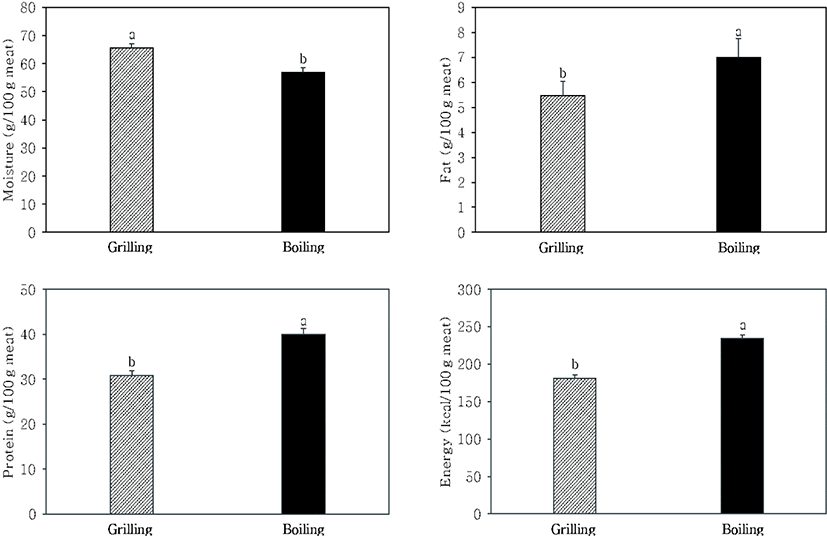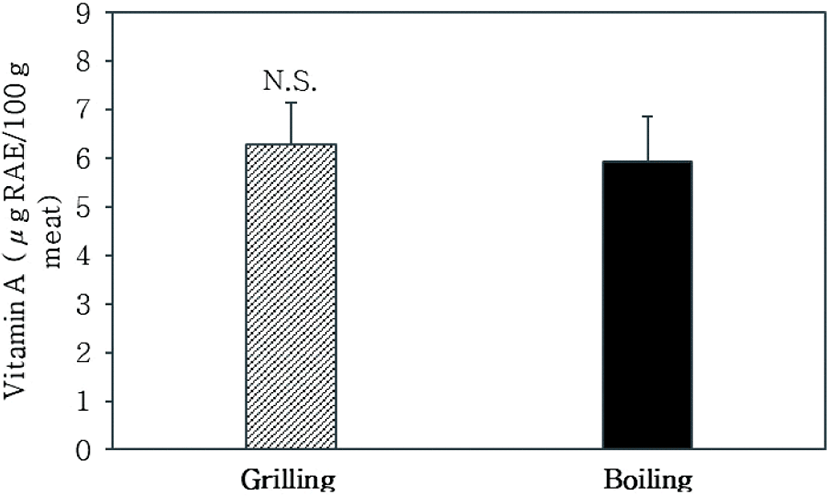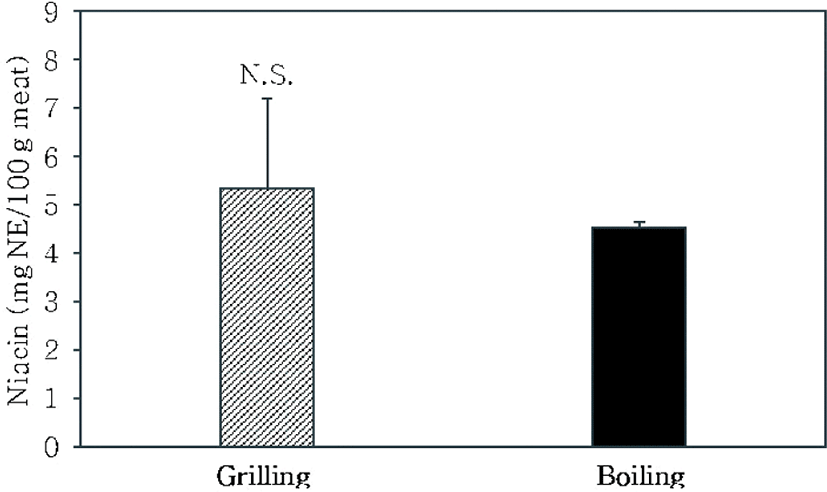Ⅰ. 서 론
염소는 소과 염소속에 속하는 동물로 우리나라에서는 축산법과 축산물 위생관리법에 따라 소, 돼지, 닭, 오리 등과 더불어 가축에 포함되며, 염소를 도축해 생산한 식육과 가공품은 축산물로 유통할 수 있다(MAFRA, 2022; MFDS, 2022). 최근 2020년에 우리나라 염소 사육 농장수와 마릿수는 12,809호 및 507,991마리로 2014년과 대비해 각각 115.4% 및 102.6%로 증가하였다(MAFRA, 2015; MAFRA, 2021). 염소 사육 마릿수가 증가함에 따라 도축 마릿수 역시 2020년에 161,667마리로 2014년 69,971마리와 비교 시 131.1%로 현저하게 증가한 상황이다(APQA, 2015; APQA, 2021). 총 인구수(Statistics Korea, 2022) 및 도축실적 통계자료에 근거한 우리나라 염소고기 소비량은 연간 1인당 약 0.06 kg으로 소·돼지·닭고기 등에 비해 저조하지만, 사육 및 도축 마릿수의 지속적인 증가를 통해 미루어 본다면, 향후 염소고기 소비는 점차 확대될 것으로 전망된다.
우리나라 인구구조는 출산율 저하와 베이비붐 세대의 고령화로 인해 빠른 속도로 초고령사회(super-aged society)에 진입하고 있다. 2050년대 이후에는 고령자가 전체 인구의 55% 이상을 차지할 것으로 예측되며(Statistics Korea, 2022), 이로 인해 65세 이상 고령자가 미래의 최대 식품 소비층으로 부각되고 있다. 하지만 고령자는 저작, 삼킴 및 소화와 같은 섭식 기능 저하로 중년 이하 연령층보다 전체 식품 소비량이 낮으며, 축산물 소비량은 두류를 제외한 농산물에 비해 2배 이상 낮은 편이다(KDCA, 2022). 또한 고령자의 단백질 섭취량은 한국인 영양소 섭취기준보다 낮고, 탄수화물을 통해 섭취하는 에너지량이 중년 이하 연령층보다 높은 실정이며(KDCA, 2022), 이로 인해 고령자에서 근감소증, 당뇨병 등 질병 유병율이 증가한다. 따라서 초고령시대에 식육의 소비를 확대하고 고령자의 건강을 증진하기 위해서는 고령자의 섭식 능력에 적합하면서 영양소를 균형 있게 공급할 수 있는 축산물을 개발해야 하며, 이를 위해서는 고령친화식품 KS 인증기준(KSH 4897; MAFRA, 2019)을 충족해야 한다.
우리나라 고령친화식품 KS 인증기준은 2017년에 제정되어 2019년부터 관련 인증제가 시행되고 있다. 고령친화식품으로 인증되기 위해서 물성은 고체형 제품의 경우 hardness가 500,000 N/m2 이하, 액상형 제품의 경우 viscosity가 1,500 mPa·s 이상이어야 하며, 영양성분 함량은 단백질, vitamin A·C·D, riboflavin, niacin, 칼슘, 칼륨 및 식이섬유 중 최소 3개 이상의 성분이 한국인 영양섭취기준의 10% 이상이어야 한다. 조리방법은 식육의 영양적 조성과 연도에 영향을 미친다(Choi et al., 2016; Pohlman et al., 1997; Pistón et al., 2020; Rinaldi et al., 2014; Singh et al., 2006; Smith et al., 2011; Tangwatcharin et al., 2019). Olagunju와 Nwachukwu(2020)는 염소고기를 boiling 처리 시 grilling에 비해 수분 손실이 높아 단백질 함량이 높고 아미노산 함량은 낮았다고 보고하였으며, Ismail 등(2019)은 가열온도가 증가함에 따라 염소고기의 가열감량과 전단가가 증가했다고 보고하였다. 식육을 활용하여 고령친화식품을 개발하기 위해서는 hardness가 500,000 N/m2 이하가 되는 조리방법을 적용하면서 영양성분 함량이 기준치에 부합되는지를 평가해야 한다. 따라서 본 연구는 염소고기를 고령친화식품에 적용하기 위해 조리방법이 흑염소 교잡종 등심의 영양적 조성 및 연도에 미치는 영향을 구명하였다.
Ⅱ. 재료 및 방법
본 실험에 이용한 흑염소 교잡종(거세) 등심은 시중으로부터 5마리분을 구입하여 결체조직, 과도한 지방과 혈액을 제거한 다음 약 2.5 cm 두께로 절단하였다. 이후 좌도체 등심은 grilling 처리구, 우도체 등심은 boiling 처리구로 분류하였다. Grilling 처리구의 경우 가정용 전기그릴(OptiGrillTM+, Tefal SAS, Rumilly, France)을 이용하여 약 210°C에서 익힘 정도가 medium이 될 때까지 가열하였으며, medium의 최종 중심 온도는 Cattlemen’s Beef Board and National Cattlemen’s Beef Association(2016)의 가이드에 따라 71°C로 설정하였다. Grilling 시 소요된 시간은 10분 이내였으며, 시료의 중심온도는 digital thermometer(307B, Tecpel Co., Ltd., Xindian, Taiwan)를 이용해 측정하였다. 우도체 등심은 조리용 냄비에 차가운 물과 함께 넣고 1시간 동안 끓이면서 물의 온도를 약 100°C까지 올리고 유지하였다. 가열이 완료된 시료들은 실온에 3시간 동안 방치한 다음 일반성분, 에너지, vitamin A, niacin 및 아미노산 함량, texture profile 분석에 이용하였다.
수분, 지방 및 단백질 함량은 near-infrared spectrophotometer(FoodScanTM Lab Type, Foss Analytical A/S, Denmark)를 이용해 측정하였다. 최종 결과는 시료 100 g당 g으로 산출하였다.
에너지 함량은 Korea Food Codex(MFDS, 2021)의 방법에 따라 단백질 및 지방 함량에 energy conversion factor(FAO, 2003)인 4.27과 9.02를 각각 곱한 다음 이 둘을 합한 값으로 나타내었다.
Vitamin A 함량은 Korea Food Code(MFDS, 2021)에 준하여 분석하였다. 시료와 ethanol 30 mL, 10%(w/v) pyrogallol in ethanol 1 mL 및 potassium hydroxide 3 mL를 혼합한 후 약 95°C에서 30분 동안 가열하였다. 가열 처리가 완료된 시료를 냉각하고 3차 증류수 30 mL를 첨가하여 separatory funnel에 옮긴 다음 petroleum ether로 여러 회씩 추출하였다. 이후 추출물에 함유된 수분을 sodium sulfate anhydrous로 제거하고, 40°C에서 감압 농축한 다음 isopropanol 1 mL를 혼합하여 SuFireTM C18 column(4.6 mm × 150 mm × 3.5 μm, Waters, MA, USA)이 장착된 HPLC(1260, Agilent Technologies, Inc., CA, USA)로 분석하였다. 분석에 이용한 mobile phase는 ethanol : water(95 : 5), excitation wavelength는 340 nm, emission wavelength는 460 nm이었다. 최종 결과는 standard curve를 이용하여 시료 100 g당 μg retinol activity equivalents(RAE)로 산출하였다.
Niacin 함량은 Korea Food Code(MFDS, 2021)에 준하여 분석하였다. 시료를 5 mM sodium hexanesulfonate-0.1%(w/v) acetic acid와 혼합하고 30분 동안 초음파 처리한 후 0°C, 9,000 rpm(Avanti JXN-26, Beckman Coulter, CA, USA)에서 30분 동안 원심분리하였다. 분리된 상등액은 0.2 μm syringe filter로 여과하고, methanol과 증류수를 연속으로 통과시킨 HLB cartridge에 여과액 10 mL를 넣어 niacin과 niacinamide를 흡착시켰다. n-Hexane으로 cartridge를 세척하고, 80%(v/v) methanol을 넣은 다음 3차 증류수를 첨가하였다. 이후 Capcellpak UG120V(4.6 mm × 250 mm × 5 μm, Shiseido Co., Ltd, Japan)이 장착된 HPLC(1260, Agilent Technologies, Inc., CA, USA)에 시료 10 μL를 주입하여 분석하였다. Mobile phase A 및 B는 각각 5 mM sodium hexanesulfonate –0.1%(v/v) acetic acid와 5 mM sodium hexanesulfonate –0.1%(v/v) acetic acid : methanol(35 : 65)이었으며, 분석시간 동안 1 mL/min의 flow rate로 A : B = 100 : 0(for 3 min) → 3%/min → A : B = 70 : 30(for 7 min)이 되도록 설정하였다. Column temperature와 wavelength는 각각 40°C 및 260 nm이었으며, 최종결과는 standard curve를 이용하여 시료 100 g당 mg niacin equivalents(NE)로 산출하였다.
Amino acid 함량은 Korea Food Code(MFDS, 2021)에 준하여 분석하였다. 시료와 6 N HCl을 혼합하고 110°C에서 24시간 동안 가수분해한 후 40°C에서 감압 농축하였다. HCl이 완전히 제거된 다음 0.2 N sodium citrate buffer(pH 2.2)에 녹이고 0.45 μm membrane filter로 여과하였다. 여액은 HPLC(1260, Agilent Technologies, Inc., Palo Alto, CA, USA)에 주입하여 분석하였다. 최종 결과는 standard curve를 이용하여 시료 100 g당 g으로 산출하였다.
Texture profile 분석은 Bourne(1978)의 방법에 따라 실시하였다. 시료를 2 × 2 cm2로 정형한 후 직경 10 mm의 cylinderical probe가 장착된 universal testing machine(Model No. 5543, Instron Corp., MA, USA)으로 시료 높이의 70% 수준까지 2회씩 압착하였다. 이때 분석 조건은 load cell이 500 N, pretest 및 test speed가 1 mm/s, posttest speed가 10 mm/s이었다. 최종 결과는 SMS(1996)의 방법에 따라 산출하였다. Hardness의 경우 시료의 압착 직후 산출된 2개의 peak 중 첫번째 peak의 최고점(N)을 cylindrical probe의 평면적(m2)으로 나누었으며, springiness의 경우 두번째 peak의 최고점(N)으로 나타내었다. Cohesiveness는 두 번째 peak 면적(cm2)을 첫 번째 peak 면적(cm2)으로 나누었으며, gumminess은 hardness와 cohesiveness를 곱하였다. Chewiness의 경우 hardness, springiness 및 cohesiveness를 곱한 값으로 나타내었다.
본 실험을 통해 얻은 모든 데이터들은 SPSS(2019) program을 이용하여 분석하였다. 조리방법(grilling 및 boiling)간에 유의성 차이는 Student’s t-test에 의해 95% 수준에서 검증하였다.
Ⅲ. 결과 및 고찰
조리방법이 흑염소 교잡종 등심의 일반성분 및 에너지 함량에 미치는 영향은 Fig. 1과 같다. 일반성분 3종 중 수분 함량은 boiling 처리구가 56.94 g/100 g meat로 grilling 처리구의 65.59 g/100 g meat보다 유의적으로 낮게 나타났다(p<0.05). 하지만 지방, 단백질 및 에너지 함량은 boiling 처리구가 각각 6.99 g/100 g meat, 40.00 g/100 g meat 및 233.85 kcal/100 g meat이었으며, grilling 처리구의 5.48 g/100 g meat, 30.84 g/100 g meat 및 181.12 kcal/100 g meat에 비해 유의적으로 높은 수치를 보여 주었다(p<0.05). Olagunju와 Nwachukwu(2020)는 boiling 처리한 염소고기가 grilling 처리한 염소고기보다 지방 및 단백질 함량이 높았다고 본 실험과 동일하게 보고하였다. 고기를 가열 처리 시 고기에 함유된 수분이 외부로 유출되기 때문에 수분 함량은 감소하고 지방 및 단백질 함량은 증가하게 되며, 고기의 중심온도와 가열시간이 증가할수록 이러한 현상은 두드러지게 나타난다(Smith et al., 2011; Pathare and Roskilly, 2016). 따라서 본 연구에서 boiling 처리구가 grilling 처리구보다 수분 함량이 낮고 지방 및 단백질 함량이 높았던 이유는 boiling 처리구의 중심온도가 grilling 처리구에 비해 높았을 뿐만 아니라, 가열시간의 경우 grilling 처리구가 10분 이내였던데 반해 boiling 처리구는 1시간으로 현저하게 길었기 때문으로 판단된다. 한편 우리나라 고령친화식품 KS 인증기준(MAFRA, 2019)에 따르면, 영양성분 중 단백질 함량은 제품 100 g당 6 g 이상을 함유해야 한다. 본 실험결과에서 boiling 및 grilling 처리구의 단백질 함량은 각각 고령친화식품 기준치보다 6.7 및 5.1배 높아 고령친화식품 인증기준을 충족하는 것으로 나타났다.

조리방법이 흑염소 교잡종 등심의 vitamin A 함량에 미치는 영향은 Fig. 2와 같다. Boiling 처리구의 vitamin A 함량은 5.92 μg RAE/100 g meat이었으며, grilling 처리구의 6.28 μg RAE/100 g meat와 유의적인 차이를 보이지 않았다(p>0.05). Boiling 처리한 염소고기의 retinol 함량은 5.0 μg/100 g meat으로 보고되었으며(NAS, 2016), grilling 처리한 염소고기의 경우 5.8 μg/100 g meat로 보고되었다(Jacobson and Pethick, 2013). 이러한 선행연구의 결과는 본 연구와 유사한 수준이었다. Vitamin A 함량은 우리나라 고령친화식품 KS 인증기준(MAFRA, 2019)에서 vitamin A 함량 기준치는 제품 100 g당 75 μg RAE 이상이다. 본 실험결과에서 boiling 및 grilling 처리구의 vitamin A 함량은 각각 고령친화식품 기준치보다 11.9 및 12.7배로 현저하게 낮아 고령친화식품 인증기준을 충족하지 못하는 것으로 나타났다.

조리방법이 흑염소 교잡종 등심의 niacin 함량에 미치는 영향은 Fig. 3과 같다. Niacin 함량은 boiling 및 grilling 처리구가 각각 4.53 및 5.32 mg NE/100 g meat이었으며, 조리방법에 따른 큰 차이를 보이지 않았다(p>0.05). Johnson 등(1995)은 boiling 처리한 염소고기의 niacin 함량은 3.5-3.7 mg/100 g meat라고 보고하였고, Jacobson과 Pethick(2013)은 grilling 처리한 염소고기의 경우 4.10 mg/100 g meat라고 하였으며, 이는 본 실험결과와 유사한 수치였다. 또한 본 연구에서 조리방법에 따른 niacin 함량의 차이가 없었던 이유는 coenzyme이 열로부터 niacin을 보호하여 niacin의 분해를 막아 주기 때문이다(Severi et al., 1997). 한편 우리나라 고령친화식품 KS 인증기준(MAFRA, 2019)에서 niacin 함량 기준치는 제품 100 g당 1.6 mg NE 이상이다. 본 실험결과에서 boiling 및 grilling 처리구의 niacin 함량은 각각 고령친화식품 기준치보다 3.3 및 2.8배로 높아 고령친화식품 인증기준을 충족하였다.

조리방법이 흑염소 교잡종 등심의 amino acid 함량에 미치는 영향은 Table 1과 같다. 총 아미노산 함량은 boiling 및 grilling 처리구가 각각 17.17 및 24.28 g/100 g meat이었으며, 조리방법에 따른 유의적인 차이를 보이지 않았다(p>0.05). 비필수아미노산 중 proline 함량은 boiling 처리구의 0.36 g/100 g meat가 grilling 처리구의 0.50 g/100 g meat보다 유의적으로 낮게 나타났으나(p<0.05), 그 외에 aspartic acid, glutamic acid, serine, glycine, arginine, alanine, tyrosine 및 cysteine 함량은 조리방법에 따른 큰 차이를 보이지 않았다(p>0.05). 필수아미노산의 총 함량과 이를 구성하는 개별 아미노산 8종(histidine, threonine, valine, methionine, phenylalanine, isoleucine, leucine 및 lysine)의 함량 역시 boiling 및 grilling 처리구간에 유의적인 차이가 없는 것으로 나타났다(p>0.05). Olagunju와 Nwachukwu(2020)는 boiling 처리한 염소고기의 serine, lysine, glutamic acid, arginine 및 tyrosine 함량이 grilling 처리한 염소고기보다 낮았다고 하여 본 실험결과와 유사하게 boiling 처리에 따른 일부 아미노산 함량의 감소를 보고하였다. 이러한 이유는 boiling이 grilling에 비해 염소고기가 함유한 수분을 더 많이 외부로 유출시켰기 때문으로 판단된다.
조리방법이 흑염소 교잡종 등심의 texture profile에 미치는 영향은 Table 2와 같다. Hardness, springiness 및 gumminess는 boiling 처리구가 각각 471,949.04 N/m2, 33.22 N 및 15.93으로 grilling 처리구의 865,851.38 N/m2, 60.36 N 및 28.88보다 약 1.8배 낮은 것으로 나타났다(p<0.05). 특히, chewiness의 경우 boiling 처리구가 543.41로 grilling 처리구의 1,783.32보다 약 3.3배로 현저하게 낮은 수치를 보여 주었다(p<0.05). 가열 처리는 고기의 근섬유를 파괴하고 단백질 구조를 변성시킬 뿐만 아니라(Kadim et al., 2008; Yarmand and Homayouni, 2010), 고기의 중심온도가 증가할수록 콜라겐의 연화, 즉, 젤라틴화를 촉진한다(Lawrie, 2006; Tornberg, 2005). 우리나라 고령친화식품 KS 인증기준(MAFRA, 2019)은 고령자가 섭취할 수 있는 hardness 범위를 20,000~500,000 N/m2로 규정하고 있다. 또한 hardness의 크기에 따라 3개 단계로 분류하고 있는데, 50,000~500,000 N/m2일 경우 치아로 섭취할 수 있는 1단계, 20,000~50,000 N/m2일 경우 잇몸으로 섭취할 수 있는 2단계, 20,000 N/m2 이하일 경우 혀로 섭취할 수 있는 3단계에 속하게 된다. 본 실험결과에서 boiling 처리구의 hardness는 고령친화식품 인증기준 1단계에 속했던 반면, grilling 처리구의 경우 500,000 N/m2을 초과하여 고령친화식품 인증기준에 부적합한 것으로 나타났다. 따라서 이상의 결과를 종합해 보면, 흑염소 교잡종 등심을 boiling으로 조리했을 때 hardness가 고령친화식품 KS 인증기준을 초과했던 grilling과 달리 치아로 섭취할 수 있는 1단계의 물성이 되었다. 하지만 영양성분 측면에서는 단백질 및 niacin 2종만이 고령친화식품 KS 인증기준을 충족하였기 때문에 향후 흑염소고기를 활용한 고령친화식품을 개발하기 위해서는 vitamin A·C, riboflavin, 칼슘, 칼륨 중 1종 이상의 함량이 고령친화식품 인증기준 이상이 되도록 채소류 등 농산물, 사골, 내장 등 축산물과 식품 첨가물을 이용하여 강화해야 한다고 사료된다.
Ⅳ. 요 약
본 연구는 염소고기를 고령친화식품에 적용하기 위해 조리방법이 흑염소 교잡종 등심의 영양적 특성 및 연도에 미치는 영향을 구명하였다. 공시재료인 등심은 두 처리구로 나누어 한 처리구는 medium(71°C)으로 구웠으며, 나머지 처리구는 1시간 동안 끓인 다음 일반성분, 에너지, vitamin A, niacin 및 아미노산 함량, texture profile 분석에 이용하였다. 일반성분 함량은 boiling 처리구의 수분 함량이 grilling 처리구보다 낮았던 반면(p<0.05), 지방, 단백질 및 에너지 함량은 boiling 처리구가 높았다(p<0.05). 이중 단백질 함량은 boiling 및 grilling 처리구 모두 고령친화식품 KS 인증기준보다 5배 이상 높았다. Vitamin A 및 niacin 함량은 boiling 및 grilling 처리구간에 큰 차이가 없었으나(p>0.05), niacin 함량은 두 처리구 모두에서 고령친화식품 인증기준보다 2.8배 이상 높았다. 아미노산 함량은 총 아미노산, 비필수아미노산 및 필수아미노산 함량 모두 조리방법에 따른 차이를 보이지 않았다(p>0.05). Texture profile은 boiling 처리구의 hardness, springiness, gumminess 및 chewiness가 grilling 처리구보다 1.8배 이상 낮았으며(p<0.05), hardness의 경우 boiling 처리구가 고령친화식품 1단계에 속하였다. 따라서 흑염소 교잡종 등심을 boiling 처리 시 고령자가 섭취할 수 있는 물성이 되었으나, 고령친화식품에 적용하기 위해서는 영양성분의 추가가 필요하다고 판단된다.
